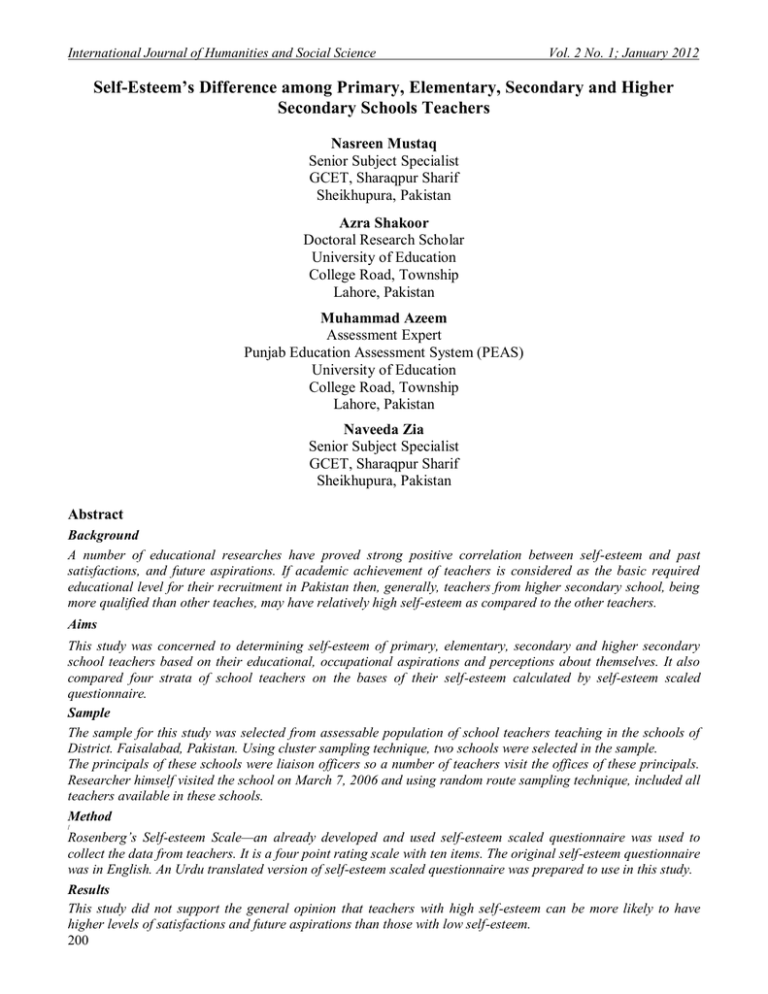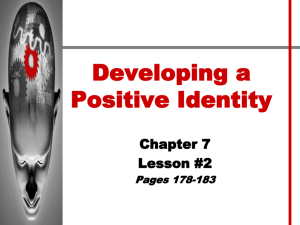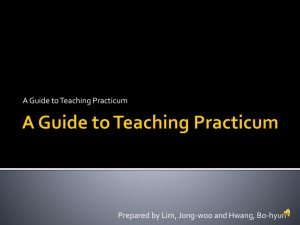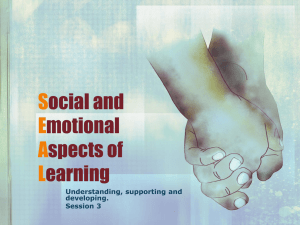Document 10467097
advertisement

International Journal of Humanities and Social Science Vol. 2 No. 1; January 2012 Self-Esteem’s Difference among Primary, Elementary, Secondary and Higher Secondary Schools Teachers Nasreen Mustaq Senior Subject Specialist GCET, Sharaqpur Sharif Sheikhupura, Pakistan Azra Shakoor Doctoral Research Scholar University of Education College Road, Township Lahore, Pakistan Muhammad Azeem Assessment Expert Punjab Education Assessment System (PEAS) University of Education College Road, Township Lahore, Pakistan Naveeda Zia Senior Subject Specialist GCET, Sharaqpur Sharif Sheikhupura, Pakistan Abstract Background A number of educational researches have proved strong positive correlation between self-esteem and past satisfactions, and future aspirations. If academic achievement of teachers is considered as the basic required educational level for their recruitment in Pakistan then, generally, teachers from higher secondary school, being more qualified than other teaches, may have relatively high self-esteem as compared to the other teachers. Aims This study was concerned to determining self-esteem of primary, elementary, secondary and higher secondary school teachers based on their educational, occupational aspirations and perceptions about themselves. It also compared four strata of school teachers on the bases of their self-esteem calculated by self-esteem scaled questionnaire. Sample The sample for this study was selected from assessable population of school teachers teaching in the schools of District. Faisalabad, Pakistan. Using cluster sampling technique, two schools were selected in the sample. The principals of these schools were liaison officers so a number of teachers visit the offices of these principals. Researcher himself visited the school on March 7, 2006 and using random route sampling technique, included all teachers available in these schools. Method [ Rosenberg’s Self-esteem Scale—an already developed and used self-esteem scaled questionnaire was used to collect the data from teachers. It is a four point rating scale with ten items. The original self-esteem questionnaire was in English. An Urdu translated version of self-esteem scaled questionnaire was prepared to use in this study. Results This study did not support the general opinion that teachers with high self-esteem can be more likely to have higher levels of satisfactions and future aspirations than those with low self-esteem. 200 © Centre for Promoting Ideas, USA www.ijhssnet.com An interactive affect was expected such that high self-esteem was related to higher aspirations. It was found at α=0.05 (p<0.05) ANOVA test failed to reject that there is no significant difference between primary, elementary, secondary and higher secondary school teachers’ self-esteem. Conclusions It was concluded that all teachers teaching in primary, elementary, secondary and higher secondary schools have approximately equal level of self-esteem. Descriptive statistics explored that among four strata of school teachers the secondary school teachers have relatively high self-esteem while elementary school teachers have relatively low self-esteem as compared to others. Introduction A number of educational researches have proved strong positive correlation between self-esteem and past satisfactions, and future aspirations. There are many other factors that have impacted on individual’s self-esteem in the society such as moral development and goal oriented thinking towards their occupation. Partington and Kimberly (2004) have conducted their research under the title ―The impact of self-esteem on academic achievement and aspirations of urban minority adolescents‖ and Brandt-Tiven and Tabitha E. (2004) have studied the connections between attributes, self-esteem, aggression, and behavior in adolescents. This study explored the self-esteem level of primary, elementary, secondary, and higher secondary school teachers. It also analyzed the apparent difference of self-esteem between primary, elementary, secondary and higher secondary school teachers. Partington and Kimberly (2004) have proved that good academic achievement has positive impact on individual’s self-esteem. If academic achievement of teachers is considered as the basic required educational level for their recruitment in Pakistan then, generally, teachers from higher secondary school may have relatively high selfesteem as compared to the other teachers but the results are quite different. Statement of the Problem The purpose of this study was to identify the self-esteem’s difference among teachers those are teaching in primary, elementary, secondary and higher secondary schools in the district Faisalabad Pakistan. Review of Related Literature Self-esteem is one of the earlier and oldest concepts that first come from William James in 1890. William (1980) define self-esteem as ―It is the comparison of actual self and ideal self‖. It involves individual’s own perception about its own qualities. It finds expression in behavior. One can interpret self-esteem as a long-term personality characteristic or as a temporary psychological condition. Thus self-esteem refers to how one think and feels about him. Self-esteem is the temperament to experience oneself as being competent to cope with the basic challenges of life and of being worthy of happiness. Self-esteem grips both self-relevant viewpoint—competent/incompetent and related self-relevant emotions—triumph/despair, pride/shame, confidence/caution assertiveness/timorousness Self-esteem or self-worth includes a person's, positive, negative or mixed, subjective appraisal, thoughts, or feelings about him or her. The more positive these thoughts and feelings are, the higher his/her self-esteem will be and conversely the more negative these thoughts and feelings are, the lower his/her self-esteem will be. One’s feeling good about himself is important as it gives him a sense of control over his life, helps him feel satisfied in his relationships, allows him to set realistic expectations for himself, and enables him to pursue his own goals. It is a very important aspect of one’s life. If one has a high level he will be confident, happy and sure of himself. He would be highly motivated and have the right attitude to succeed. Self esteem is therefore crucial to an individual and is a cornerstone of a positive attitude towards living. On the other hand one’s feeling badly about oneself, contributes to a distorted view of his and others, a lack of self-confidence, poor performance, and unhappiness. Low self esteem results from one’s having a poor self image caused by his attitude. Typically self-esteem is a ratio of individual’s successes in important areas of life to the failures in them. Maurice Rosenberg and social-learning theorists, in the mid 1960s, defined self-esteem in terms of a stable sense of personal worth or worthiness, measurable by self-report testing. This became the most frequently used definition for research but as cited by Mruk (2006) Nathaniel Branden in 1969 briefly defined self-esteem as "…the experience of being competent to cope with the basic challenges of life and being worthy of happiness". 201 International Journal of Humanities and Social Science Vol. 2 No. 1; January 2012 This two-factor approach, as some have also called it, provides a balanced definition that seems to be capable of dealing with limits of defining self-esteem primarily in terms of competence or worth alone. The common procedures used for measuring self-esteem, virtually, have relied on answers to a handful of selfreport questionnaires. ―The one most relied on was developed in 1965 by sociologist Morris Rosenberg. It seeks responses to statements such as "On the whole I am satisfied with myself," and "I feel that I have a number of good qualities." This procedure of asking people to introspect or engage in self-report is a legitimate one. But introspective data are of no value if the person is not answering truthfully, or if he is out of touch with the feelings he is supposed to report, or if he lacks an understanding of the matter at issue. All of these problems are to be expected in measuring self-esteem‖ (Campbell & Foddis, 2005). Teacher and Self-Esteem Why self-esteem of a teacher is impartment can be summarized in the following points: Teachers have a very momentous, enduring impact on all of their students. This impact involves reinforcing self-esteem in the classroom that is associated with increased motivation and learning. Thus it involves not only the teaching of particular academic skills, but as importantly, the fostering of student self-esteem. Teachers may not require additional time to use of strategies to foster self-esteem that can go hand-inglove with teaching academic skills, and from teachers. If anything that focus on self-esteem can create a more exciting, satisfying teaching learning environment. Self-esteem strategies, also, do not require any additional funds, financial assistance or a budget by the teachers, but rather the sensitivity, respect, and caring of teachers. Self- esteem strategies adopted by teachers involve helping students feel they belong and are welcome in the school setting, providing them with responsibilities through which they perceive themselves as contributing and making a difference, offering them chance to make choices and decisions and solve problems, and communicating encouragement and positive feedback. While these kinds of positive interventions are important for all students, they are particularly relevant for students who find learning problematic. Many of the teachers can help Children with learning difficulties. Unfortunately, even today, continue to hear accusations about children with learning difficulties that they are lazy and unmotivated or that they should pay closer attention so that they wouldn't have to ask so many questions. Teachers must constantly communicate to students that mistakes are part of the learning process and that no student should ever feel embarrassed to ask questions if they do not understand something. The following studies were, also, helpful in designing and conducting this project. Partington, Kimberly (2004) have conducted their research under the title ―The impact of self-esteem on academic achievement and aspirations of urban minority adolescents‖ Brandt-Tiven, Tabitha E.(2004) have conducted their research under the title ―Connections between attributes, self-esteem, aggression, and behavior in adolescents‖ Hypotheses 1. (Ho) There is no significant difference between primary, elementary, secondary and higher secondary school teachers’ self-esteem. 2. (H1) All the teachers have high self-esteem. Method Sample: The sample for this study was selected from assessable population of school teachers teaching in the schools of District. Faisalabad, Pakistan. Using cluster sampling technique, following two schools of Tehsil Chak Jhumra 37700 District Faisalabad were selected in the sample. 1. Government Higher Secondary School Chak Jhumra Distt. Faisalabad. 2. Government Girls Higher Secondary School Chak Jhumra Distt. Faisalabad. The principals of these schools are liaison officers for schools in Tehsil Chak Jhumra, so a number of teachers visit the offices of these principals. Researcher himself visited the school on March 7, 2006 and using random route sampling technique, included all teachers available in these schools. 202 © Centre for Promoting Ideas, USA www.ijhssnet.com Instrument: Rosenberg’s Self-esteem Scale—an already developed and used self-esteem scaled questionnaire was used to collect the data from teachers. It is a four point rating scale with ten items. The original self-esteem questionnaire was in English. An Urdu translated version of self-esteem scaled questionnaire was prepared and validated by the three faculty members and four doctoral researchers at Division of Education, University of Education, Lahore, Pakistan. Teachers’ responses were in descriptive form as strongly agree/agree/not agree/strongly not agree. The descriptive statements were converted into numerical form as: _____________________________________________________________ Rating For Negative Questions For Positive Questions _____________________________________________________________ Strongly Agree 1 4 Agree 2 3 Not Agree 3 2 Strongly not Agree 4 1 ______________________________________________________________ (Numeric conversion of Questionnaire Items) Procedure: Researcher itself visited the schools on March 7, 2006, and distributed 125 questionnaires to the teachers. The researcher collected questionnaires personally. Total of 115 questionnaires were returned. Four questionnaires were incomplete so not consider for analysis. Thus 111 questionnaires were analyzed for results. Results There were four strata-- primary, elementary, secondary and higher secondary school teaches, in the population and the data was collected for each strata. The numbers of individuals in strata were different due to random rout sampling, so the correlation between strata for self-esteem was not possible. ANOVA test was used for testing null hypothesis ―There is no significant difference between primary, elementary, secondary and higher secondary school teachers’ self-esteem‖ at significant level α=0.05. 1) ANOVA test was failed to reject the null hypothesis ―There is no significant difference between primary, elementary, secondary and higher secondary school teachers’ self-esteem‖ therefore it is concluded that there is no significant difference of self-esteem’s level between primary, elementary, secondary and higher secondary school teachers. Descriptive statistics is applied for testing of second hypothesis ―All the teachers have high self-esteem‖. Mean self-esteem score is used for ranking of four strata of school teachers. 2) Descriptive statistical information declared that secondary school teachers have relatively high self-esteem level than other three groups. On the basis of results of self-esteem scaled questionnaire, primary, elementary, secondary and higher secondary school teachers are ranked as: Table I: Teacher Category and their Rank _________________________________________________ Teacher Category Rank _________________________________________________ Secondary School Teacher 1st Higher Secondary School Teacher 2nd Primary School Teacher 3rd Elementary School Teacher 4th _________________________________________________________________________ 3) Teachers from higher secondary school have higher academic achievements than secondary school teachers but higher secondary school teachers have relatively low self-esteem level than secondary school teachers. Similar is the case with elementary school teachers as compared to primary school teachers. Thus this study does not support the results as Partington, Kimberly (2004) have proved that better academic achievement has positive impact on individual’s self-esteem. 203 International Journal of Humanities and Social Science Vol. 2 No. 1; January 2012 4) The total score of the scale was 40 and mean score of teachers was 19.9 and 19.7 respectively. Therefore teachers of primary and elementary schools have self-esteem level below 50%. It may be concluded that these teachers are either may not satisfied themselves or may not occupational oriented. Table II: Descriptive statistical information Teacher Primary Elementary Secondary Higher Secondary Mean of SelfEsteem 19.92 19.69 21.06 20.25 S.D 0.5976 Z-Score Zab=100Z+500 -0.1841 -0.3221 0.4948 0.0113 481 467 549 501 5) Secondary and higher secondary school teachers of District Faisalabad have self-esteem level ranging from 51% to 53% only. 6) Secondary school teachers are relatively more consistent in their thinking than primary, secondary and higher school teachers. Conclusions It is clear that all school teachers of primary, elementary, secondary, and higher secondary schools in District Faisalabad are consistent in their thinking, perceptions for future and level of self-esteem. It may be due the job environment in the education department. Most of the people join teaching when they have no other good job opportunity or majority of teachers have upto average IQ. No or slow promotions of teachers may also contributing towards teachers’ average level of self-esteem. This is very alarming situation. As in teachinglearning process, teachers have pivotal role so teachers’ low self-esteem may effect the students’ motivations towards coping themselves with national and international challenges. Low self-esteem may affect teachers’ efficiencies and competencies to cop with teaching strategies resultantly classroom interaction. Figure I: Comparison of Self-Esteem among Teachers Over all conclusions School teachers from District Faisalabad may have: relatively poor perception about themselves hopeless aspirations about their future less goal oriented attitude towards their profession dissatisfaction concerning to their high academic achievements and low position in teaching profession moral development problems These and other, unidentified, factors may are contributing towards relatively poor level of self-esteem of elementary school teachers. 204 © Centre for Promoting Ideas, USA www.ijhssnet.com School teachers, being in high IQ valued profession demanding high self-esteem, positive thinking, strong future aspiration and goal-oriented, are possessed average self-esteem like common man. Responsible factors must be identified for remedy. Recommendations Diagnosing studies should be conducted to explore the factors that contribute towards average level of self-esteem of school teachers and poor perceptions about themselves. Need assessment studies about teacher training programs and courses may helpful in reshaping teachers’ perceptions about themselves. References Andrew M. Mecca, Neil J. Smelser and John Vasconcellos (Eds.) The Social Importance of Self-esteem University of California Press, 1989. Barbara Lerner, "Self-Esteem and Excellence: The Choice and the Paradox," American Educator, Winter 1985. Branden, N. (1969). The psychology of self-esteem. New York: Bantam. Brandt-Tiven & Tabitha E. (2004). Connections between Attributes, Self-Esteem, Aggression, and Behavior in Adolescents. UMI ProQuest Digital Dissertations. Campbell, R. & Foddis, W. (2005). Is High Self-Esteem Bad for You? Retrieved on 28-04-2007 from http://www.objectivistcenter.org/showcontent.aspx?ct=670&printer=True Crocker, J., & Park, L. E. (2004). The costly pursuit of self-esteem. Psychological Bulletin, 130(3), 392–414. Fraenkel, J. R. & Wallen, N. E. (2000).How to Design & Evaluate Research in Education. (4 th ed.). New York: McGraw-Hill Higher Education. Gay, L. R. (1996). Educational Research: Competencies for Analysis and Application. (5 th Ed.). Prentice-Hall. James, W. (1983). The principles of psychology. Cambridge, MA: Harvard University Press. (Original work published 1890) Mruk, C. (2006). Self-Esteem research, theory, and practice: Toward a positive psychology of self-esteem (3rd ed.). New York: Springer. Retrieved on 28-04-2007 from http://en.wikipedia.org/wiki/Selfesteem#_ref-0 Partington & Kimberly. (2004). the Impact of Self-Esteem on Academic Achievement and Aspirations of Urban Minority Adolescents. UMI ProQuest Digital Dissertations. Rosenberg’s Self-esteem Scale retrieved from http://www.bsos.umd.edu/socy/grad/socpsy_rosenberg.html Ruggiero, Vincent R. "Bad Attitude: Confronting the Views That Hinder Student's Learning" American Educator, Summer 2000. Trochim, W. M. K. (2004). Research Methods. (2nd Ed.).USA: Atomic Dog Publishing. Wiersma, W. (1986).Research Methods in Education: An Introduction. Boston: Allyn and Bacon, Inc. 205






